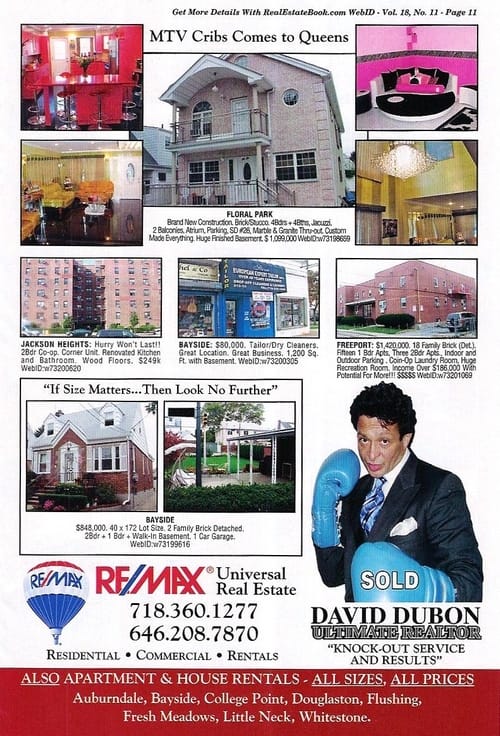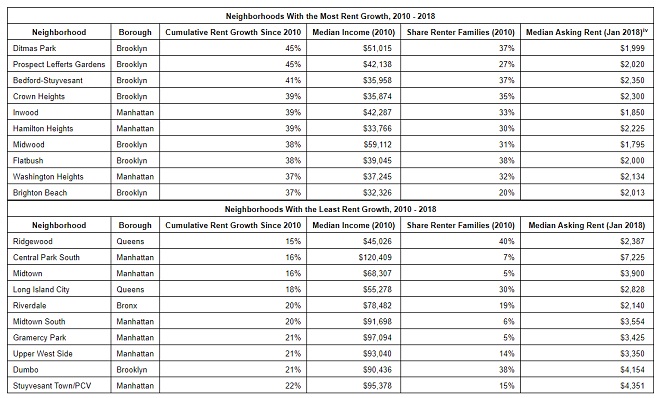Rents in family-dense NYC neighborhoods grew five percent faster over the past 10 years than rents in areas with fewer families, according to a new StreetEasy study
New York, NY – Aug. 27, 2018 (PRNewswire)
- Rents in New York City have increased 31 percent since 2010, according to the StreetEasy Rent Index. Some neighborhoods saw rents rise as little as 15 percent, while rents in others rose as much as 45 percent.
- Rents in neighborhoods where at least a quarter of residents were families with children grew 5 percent faster than neighborhoods in which less than a quarter of residents were families.
- In neighborhoods with a median household income below New York City’s 2010 median, rents grew 6 percent more than in areas with a household income above the citywide median.
- A household spending $2,000 per month on rent in 2010 would be paying an additional $620 per month or $7,440 more per year in 2018.
Since the end of the financial crisis(i), monthly rents for New York City apartments listed on StreetEasy increased 31 percent or $653(ii), according to StreetEasy’s annual rent affordability study. While the pace of rent growth has varied widely across neighborhoods — from 15 percent in Ridgewood, Queens, to 45 percent in Ditmas Park, Brooklyn — rents are growing fastest in areas with higher shares of low-income residents and renter households with children(iii).

Rents in neighborhoods where families make up at least 25 percent of residents grew 32 percent on average, 5 percent faster than neighborhoods where less than one quarter of residents had children. Manhattan neighborhoods including Midtown, Gramercy Park, and the Financial District, where less than 10 percent of renters have children, were among the neighborhoods with the slowest-growing rents. Outer-borough areas such as Ditmas Park, Elmhurst, and University Heights, where more than a third of renters have children, were among the neighborhoods where rents rose the most.
Rent increases have also hit low-income households especially hard. In the neighborhoods with household incomes below the city’s 2010 median of $50,285, rents grew by 33 percent. Over the same 10-year period, rents in neighborhoods with an above-median income grew by just 27 percent — 6 percent slower. For a household spending $2,000 per month on rent in 2010, this 6 percent additional growth adds up to an additional $125 per month or $1,500 per year in 2018. In neighborhoods like Prospect Lefferts Gardens and Midwood, dozens of apartments now ask for rents more than 40 percent higher than at the beginning of the decade.
“Rents have risen in the city, but not all New Yorkers have felt the same effects,” says StreetEasy Senior Economist Grant Long. “Residents who already struggle to make ends meet and renters dealing with the high costs of childcare are predominantly living in areas that see the most dramatic rent growth. These are often residents who have little financial flexibility to begin with. As a greater share of their incomes goes towards rent, it’s increasingly difficult for families to save for a down payment on a home, their children’s college education, or emergencies.”
The StreetEasy study also reveals some of the impacts of zoning changes around the city. Seven of the top 10 neighborhoods with fastest rent growth were in part downzoned over the last two decades, limiting growth in the supply of housing. Meanwhile, three of the 10 neighborhoods with slowest rent growth — Long Island City, Dumbo, and the Upper West Side — were in part upzoned between 2007 and 2009. Taken together, these findings suggest that the zoning-related supply factors in some areas of the city may have played a role in mitigating or accelerating overall rent growth.

About StreetEasy
StreetEasy is New York City’s leading local real estate marketplace on mobile and the web, providing accurate and comprehensive for-sale and for-rent listings from hundreds of real estate brokerages throughout New York City and the NYC metropolitan area. StreetEasy adds layers of proprietary data and useful search tools to help home shoppers and real estate professionals navigate the complex real estate markets within the five boroughs of New York City, as well as Northern New Jersey.
Launched in 2006, StreetEasy is based in the Flatiron neighborhood of Manhattan. StreetEasy is owned and operated by Zillow Group (NASDAQ :Z and ZG).
StreetEasy is a registered trademark of Zillow, Inc.
(i) For the purpose of this analysis, StreetEasy examined rent growth between January 2010 and January 2018.
(ii) Rent growth in New York City and the 88 neighborhoods in this analysis were estimated using the StreetEasy Rent Index. More on the methodology here: https://streeteasy.com/blog/methodology-price-and-rent-indices/
(iii) The share of renter families and median income for residents in each neighborhood were estimated using the U.S. Census American Community Survey, five-year estimates.
(iv) Median asking rent based on active StreetEasy rental listings in January 2018.
Like this:
Like Loading...


